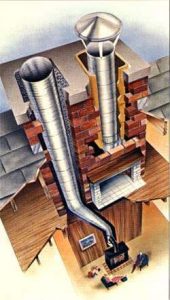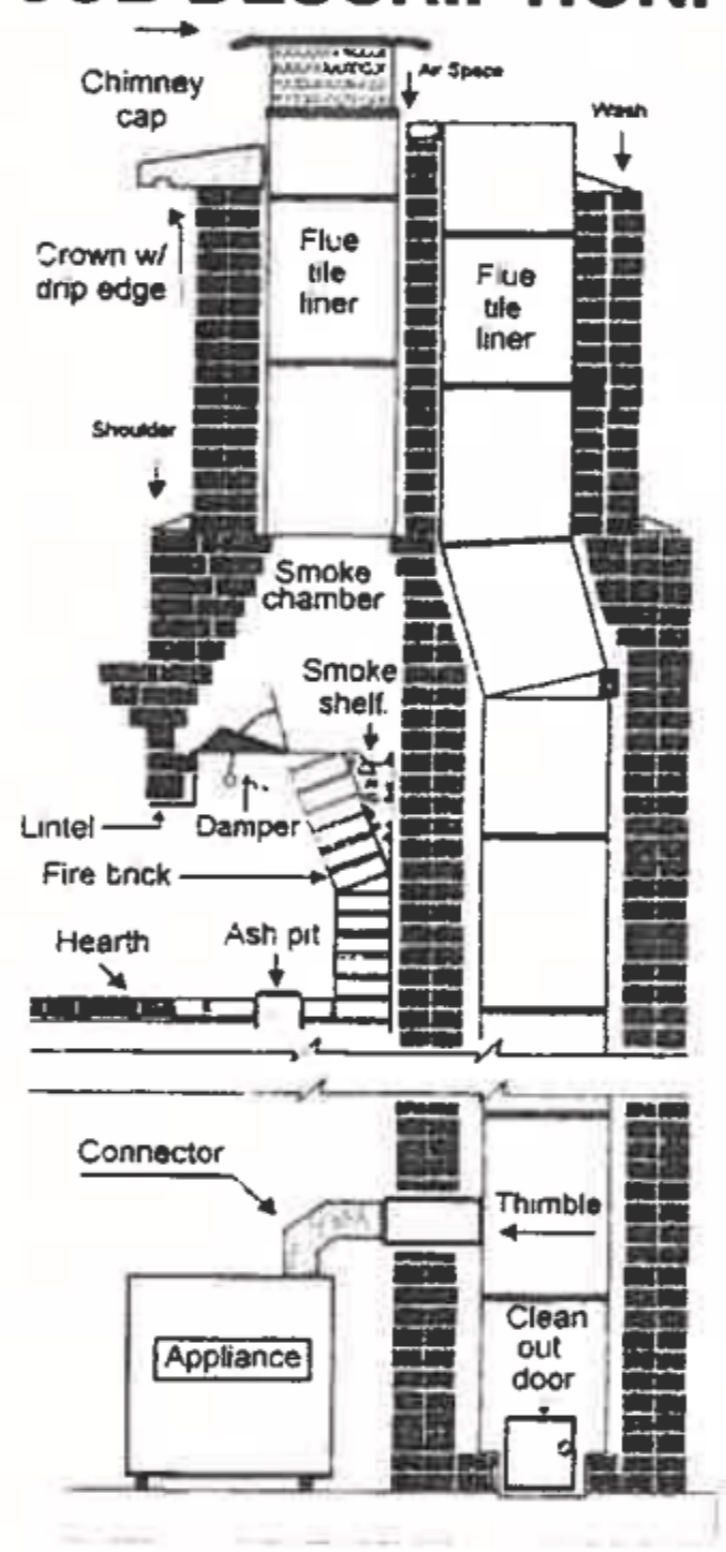Chimney Liners serve three main functions:
Absolute Chimney and Fireplace Restoration
Pittsburgh Chimney Liners & Relinings

Chimney lining is the most important piece of the chimney. It is the part that protects the chimney from overheating or catching fire.
Although building codes vary from one state or locality to another, the installation of a chimney liner lining has been recommended since the early part of this century, and indeed most fire codes now mandate liners.
In the 1940’s and again in the 1980’s, masonry chimneys were tested by the National Bureau or Standards for durability due to rising concerns about their performance and safety. The tests revealed that unlined chimneys were so unsafe that researchers characterized building a chimney without a liner as “little less than criminal”.
Before the 1900s chimneys were lined with mortar. Today, popular liner materials are stainless-steel. Though metal and stainless-steel liners often last long, over time sulfur and water mix inside the chimney, and the mixture starts to corrode the liner resulting in the liners pulling away from the framing and walls.

1) The liner protects the house from heat transfer to combustibles. In the NBS tests, unlined chimneys allowed heat to move through the chimney so rapidly that the adjacent woodwork caught fire in only 3 1/2 hours.
2) Liners protect the masonry from the corrosive byproducts of combustion. In the tests it was determined that if the flue gases were allowed to penetrate to the brick and mortar, the result would be a reduction in the usable life of the chimney. The flue gases are acidic in nature and literally eat away at the mortar joints from inside the chimney. As the mortar joints erode, heat transfers more rapidly to the nearby combustibles and dangerous gases such as carbon monoxide can leak into the living areas of the home.
3) Liners provide a correctly sized flue for optimum efficiency of appliances. Modern wood stoves and furnaces require a correctly sized flue to perform properly. The chimney is responsible for not only allowing the products of combustion a passage out of the house, but the draft generated by the chimney also supplies the combustion air to the appliance. An incorrectly sized liner can lead to excessive creosote buildup in wood burning stoves, and the production of carbon monoxide with conventional fuels.
Causes for Chimney Relining
A properly sized liner results in proper air control and an incorrectly sized liner will cause excessive creosote build-up in the chimney. Tests conducted by the NBS showed that flue gases entering into brick and mortar can decrease the usable lifetime of a chimney. This may cause harmful gases to leak into the living space of a home.
Chimney liners come in three main types
1) Clay tiles: The most common type of masonry chimney liners. They are inexpensive, readily available, and perform quite well for open fireplace chimneys that are properly maintained. There are two disadvantages to clay tiles. The first is that, being a ceramic product, they cannot rapidly absorb and evenly distribute heat during the rapid temperature rise that occurs during a chimney fire. This uneven heating produces an unequal expansion which in turn causes the flue tiles to crack and split apart. This is similar to immersing a cold drinking glass in very hot water. It will instantly shatter. A chimney with cracked chimney liners must be repaired before use. The second disadvantage is that tiles cannot adequately contain the liquid combustion byproducts produced by modern appliances.
2) Metal chimney liners: Usually of stainless steel, are primarily used to upgrade and repair existing chimneys. These liner systems are U.L. tested and listed, and if properly installed and maintained are extremely safe and durable. Stainless steel is suitable for woodburning applications. It is usually required that high temperature insulation be used in conjunction with the liners for safety and performance considerations.
3) Cast-in-place chimney liners:Lightweight, castable, cement like products that are installed inside the chimney forming a smooth, seamless, insulated passageway for the flue gasses. They can improve the structural integrity of aging chimneys, and are permanent liners suitable for all fuels.
Considering the dangers of old unlined or damaged chimneys, and the many cost effective options now available to make these chimneys safe components of the home heating system, we suggest having your chimney professionally inspected to be sure it meets modern standards.
We serve the Pittsburgh area including surrounding communities. Call 412-751-5525 today for an appointment to meet with a trusted chimney expert at Absolute Chimney & Restoration.
We work with the below brands and more!
Chimney and Fireplace Liners
M-Flex Stainless Steel Chimney Liners
M-Flex Stainless Steel Plus Chimney Liners
M-Flex Aluminium Chimney Liners
Premier Flex Heavy Wall Stainless Steel chimney Liners
Premier Flex Lite Stainless Steel Chimney Liners
Selkirk Model ultra Temp Class A Double Wall Insulated Stainless Steel Chimney Stacks

Best Flex Chimney Liners
Flex Aluminium Chimney Liner Kits
Flex Stainless Steel Liners
Guardian Chimney Liner Systems
Jeremias Exhaust Systems
Chimney Products Inc
Stainless Steel Flue Flex Chimney Liners
Aluminium Flue Flex Chimney Liners
Smart Flex Chimney Liners
Smart Flex Stainless Steel Chimney Liners
Smart Flex Aluminium Chimney Liners
Duratech Chimney Pipes
Ventinox Stainless Steel Chimney Liners
Premium Forever Flex Stainless Steel Chimney Liners
Duratech Duraliner
Selkirk Flexi-Liner Aluminium Liners
Call 412-751-5525 today for chimney and fireplace liners for: Fireplace and chimney flues, furnace and boiler flues, hot water tank flues, free-standing wood stove flues, and wood insert fireplace flues.
Facts on Furnace Flue Liner in Masonry Chimneys
Efflorescence On Brick
Efflorescence is a common symptom of condensation in the chimney, leaving behind white salt deposits
Damaged Brickwork Above the Roofline
This is a result of years of condensation on a masonry chimney. Masonry chimneys either need rebuilding or tuckpointing to repair this issue, after a furnace liner is installed.
Staining on Walls Inside the Home Near the Chimney
If problems with a leaky chimney go unaddressed, it could lead to thousands of dollars of damage to your home.
Carbon Monoxide Getting Into Home
Carbon monoxide is often referred to as the silent killer. This poisonous gas is both colorless, odorless and tasteless. Mild exposure to the gas can lead to flu-like symptoms.
Blockages in Flue
Flue tiles can become damaged due to condensation and block the chimney, causing a carbon monoxide problem in the home.
Chimney Safety Institute of America
According to the CSIA (csia.org), problems such as gaps, cracks, and spalling in your chimney's flue can present series risks to your home and family, because your chimney can no longer perform its intended function - to safely contain and vent the products of combustion to the outside.
National Fire Protection Association (NFPA)
"If the flue liner in a chimney has softened, cracked or otherwise deteriorated so that it no longer has the ability to contain the products of combusion (i.e, heat, moisture, creosote, and flue gases), it shall be removed and replaced, and repaired or relined..." NFPA 211 - Standard for chimneys, fireplaces, Vents, and Solid Fuel - Burning Appliances (200^